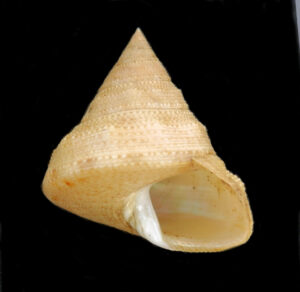Nobel Top Shells of the Calliostomidae Family
 Nephelo Top Shell, Calliostoma nepheloide
Nephelo Top Shell, Calliostoma nepheloide
Nobel Top Shells of the Calliostomidae Family are conical shells that are comprised of several flat sided or rounded whorls. They have exterior sculpture that is finely beaded, knobbed or smooth and have a round, mother of pearl, aperture. The family name Calliostoma comes from the Greek words for “beautiful mouth”, referring to the iridescent aperture. Living specimens have a round, multi-spiral operculum.
Noble Top Shells are found on hard substrate but some species are found attached to plants or over and within mud and sand substrate from the intertidal zone to very deep waters. They feed on detritus, other invertebrates and plants. In turn they are preyed upon by shore birds, crabs, fish and octopus. Noble Top Shells differ in their mode of reproduction from most other Top Shells. Most Top Shells cast their gametes into the water column where fertilization takes place and the resulting veliger larvae drift as plankton before settling to the bottom as snails. Noble Top Snails lay their eggs in a gelatinous ribbon which are then fertilized; they bypass the planktonic stage, and develop directly into snails. Noble Top Shells are found in tropical and temperate seas.